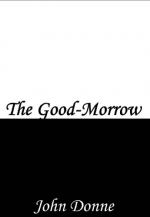
|
| Name: _________________________ | Period: ___________________ |
This quiz consists of 5 multiple choice and 5 short answer questions through Section 1: "The Good Morrow," lines 1-21.
Multiple Choice Questions
1. What does the phrase "'Twas so" in line 5 mean?
(a) It introduces the logical consequences of the ideas offered in lines 1-4.
(b) It creates a shift in time, indicating that lines 5-7 take place in the future.
(c) It makes clear that the whole stanza is hypothetical, not a reality.
(d) It confirms that the possibilities outlined in lines 1-4 were actually true.
2. Which term best describes the rhyming in lines 13 and 14, "Let maps to other, worlds on worlds have shown,/ Let us possess one world, each hath one, and is one"?
(a) Eye rhyme.
(b) Identical rhyme.
(c) Slant rhyme.
(d) True rhyme.
3. Although the speaker has indicated that each lover is a complete world, where does the diction suggest that each is actually incomplete without the other?
(a) Line 19 "equally."
(b) Line 11, "one little room."
(c) Line 14, "each hath one, and is one."
(d) Line 17, "hemispheres."
4. In lines 2 and 3, what does the speaker compare himself and his lover to, before their relationship began?
(a) Inanimate objects.
(b) Babies.
(c) Animals.
(d) Farmers.
5. What is the time of day in this poem's setting?
(a) Dusk.
(b) Morning.
(c) Midnight.
(d) Noon.
Short Answer Questions
1. Line 10, "For love, all love of other sights controls," contains an example of which technique?
2. What do the poem's final three lines suggest is true about the speaker's and his lover's relationship?
3. Lines 12-14, "Let sea-discoverers to new worlds have gone,/ Let maps to other, worlds on worlds have shown,/ Let us possess one world, each hath one, and is one," contain an example of which technique?
4. Line 11, "And makes one little room an everywhere," contains an example of which technique?
5. Which technique is used repeatedly in the first quatrain?
|
This section contains 329 words (approx. 2 pages at 300 words per page) |

|




